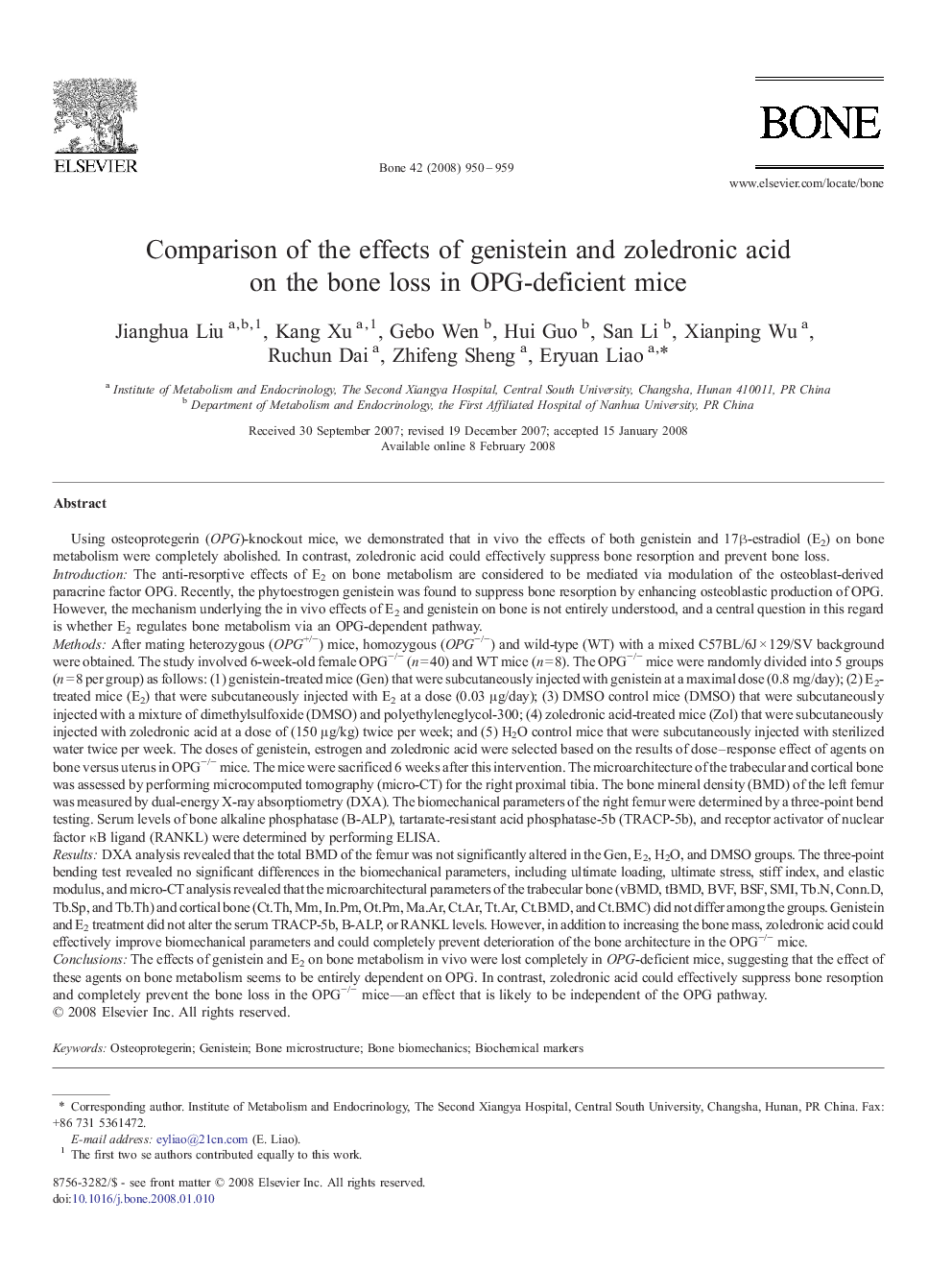| کد مقاله | کد نشریه | سال انتشار | مقاله انگلیسی | نسخه تمام متن |
|---|---|---|---|---|
| 2781384 | 1153319 | 2008 | 10 صفحه PDF | دانلود رایگان |

Using osteoprotegerin (OPG)-knockout mice, we demonstrated that in vivo the effects of both genistein and 17β-estradiol (E2) on bone metabolism were completely abolished. In contrast, zoledronic acid could effectively suppress bone resorption and prevent bone loss.IntroductionThe anti-resorptive effects of E2 on bone metabolism are considered to be mediated via modulation of the osteoblast-derived paracrine factor OPG. Recently, the phytoestrogen genistein was found to suppress bone resorption by enhancing osteoblastic production of OPG. However, the mechanism underlying the in vivo effects of E2 and genistein on bone is not entirely understood, and a central question in this regard is whether E2 regulates bone metabolism via an OPG-dependent pathway.MethodsAfter mating heterozygous (OPG+/−) mice, homozygous (OPG−/−) and wild-type (WT) with a mixed C57BL/6J × 129/SV background were obtained. The study involved 6-week-old female OPG−/− (n = 40) and WT mice (n = 8). The OPG−/− mice were randomly divided into 5 groups (n = 8 per group) as follows: (1) genistein-treated mice (Gen) that were subcutaneously injected with genistein at a maximal dose (0.8 mg/day); (2) E2-treated mice (E2) that were subcutaneously injected with E2 at a dose (0.03 μg/day); (3) DMSO control mice (DMSO) that were subcutaneously injected with a mixture of dimethylsulfoxide (DMSO) and polyethyleneglycol-300; (4) zoledronic acid-treated mice (Zol) that were subcutaneously injected with zoledronic acid at a dose of (150 μg/kg) twice per week; and (5) H2O control mice that were subcutaneously injected with sterilized water twice per week. The doses of genistein, estrogen and zoledronic acid were selected based on the results of dose–response effect of agents on bone versus uterus in OPG−/− mice. The mice were sacrificed 6 weeks after this intervention. The microarchitecture of the trabecular and cortical bone was assessed by performing microcomputed tomography (micro-CT) for the right proximal tibia. The bone mineral density (BMD) of the left femur was measured by dual-energy X-ray absorptiometry (DXA). The biomechanical parameters of the right femur were determined by a three-point bend testing. Serum levels of bone alkaline phosphatase (B-ALP), tartarate-resistant acid phosphatase-5b (TRACP-5b), and receptor activator of nuclear factor κB ligand (RANKL) were determined by performing ELISA.ResultsDXA analysis revealed that the total BMD of the femur was not significantly altered in the Gen, E2, H2O, and DMSO groups. The three-point bending test revealed no significant differences in the biomechanical parameters, including ultimate loading, ultimate stress, stiff index, and elastic modulus, and micro-CT analysis revealed that the microarchitectural parameters of the trabecular bone (vBMD, tBMD, BVF, BSF, SMI, Tb.N, Conn.D, Tb.Sp, and Tb.Th) and cortical bone (Ct.Th, Mm, In.Pm, Ot.Pm, Ma.Ar, Ct.Ar, Tt.Ar, Ct.BMD, and Ct.BMC) did not differ among the groups. Genistein and E2 treatment did not alter the serum TRACP-5b, B-ALP, or RANKL levels. However, in addition to increasing the bone mass, zoledronic acid could effectively improve biomechanical parameters and could completely prevent deterioration of the bone architecture in the OPG−/− mice.ConclusionsThe effects of genistein and E2 on bone metabolism in vivo were lost completely in OPG-deficient mice, suggesting that the effect of these agents on bone metabolism seems to be entirely dependent on OPG. In contrast, zoledronic acid could effectively suppress bone resorption and completely prevent the bone loss in the OPG−/− mice—an effect that is likely to be independent of the OPG pathway.
Journal: Bone - Volume 42, Issue 5, May 2008, Pages 950–959